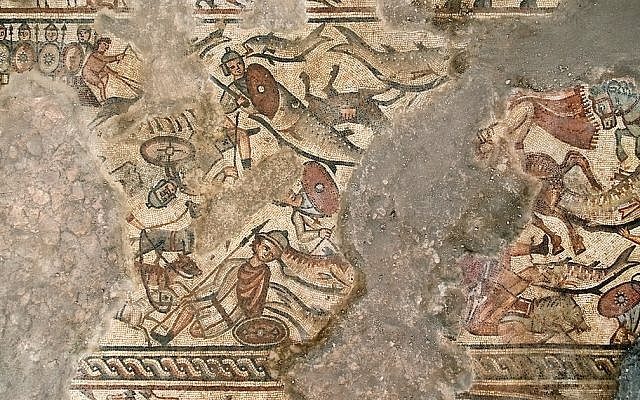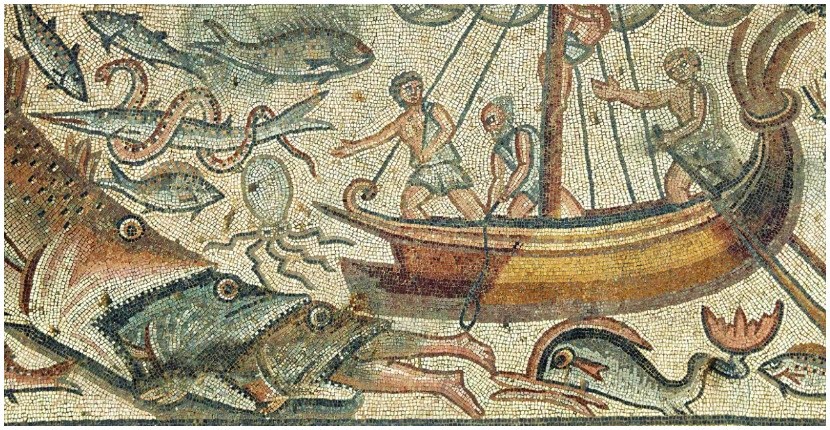A 1,600-year-old biblical triptych of mosaics made of tiny stone cubes (or tesserae) was discovered at a synagogue in the ancient Galilean village of Huqoq in Israel in an excavation led by professor Jodi Magness of the University of North Carolina at Chapel Hill.
“We’ve uncovered the first depiction of the episode of Elim ever found in ancient Jewish art,” said Dr. Magness. This comes on the heels of earlier mosaic discoveries at this site which include depictions of The Tower of Babel, Jonah and the Giant Fish, and the Parting of the Red Sea.
Dr. Magness together with a team of researchers and students uncovered the first ancient Jewish depiction of the Elim episode from the Book of Exodus. The mosaic depicts the experience of the Israelites camping at Elim after leaving Egypt and wandering in the wilderness without water, which is described in Exodus 15:27. The 15th chapter and 27th verse describes the site of Elim in which exiled Egyptians sought refuge after exhaustive travel.

“Elim is where the Israelites camped after leaving Egypt and wandering in the wilderness without water,” said Dr. Magness. The Biblical mosaics discovered in the 5th century synagogue depicts a scene from the book of Exodus. The 15th chapter and 27th verse describes the site of Elim in which exiled Egyptians sought refuge after exhaustive travel.

Magness said that the Elim panel “is interesting as it is generally considered a fairly minor episode in the Israelites’ desert wanderings, which raises the question of why it was significant to this Jewish congregation in Lower Galilee.”

Dr. Magness told the Jewish Press, “The mosaic is divided into three horizontal strips, or registers. We see clusters of dates being harvested by male agricultural workers wearing loincloths, who are sliding the dates down ropes held by other men. The middle register shows a row of wells alternating with date palms. On the left side of the panel, a man in a short tunic is carrying a water jar and entering the arched gate of a city flanked by crenellated towers. An inscription above the gate reads, ‘And they came to Elim.’ ”

It is the ninth year that the university has been digging at the site. Other mosaics have been uncovered. Another important discovery: “Chapter 7 in the book of Daniel describes four beasts which represent the four kingdoms leading up to the end of days,” Dr. Magness said. “This year our team discovered mosaics in the synagogue’s north aisle depicting these four beasts, as indicated by a fragmentary Aramaic inscription referring to the first beast: a lion with eagle’s wings. The lion itself is not preserved, nor is the third beast. However, the second beast from Daniel 7:4 – a bear with three ribs protruding from its mouth – is preserved. So is most of the fourth beast, which is described in Daniel 7:7 as having iron teeth.”

The historical record for an exodus of Jews from Egypt has been much discussed. The May/June 2016 issue of Biblical Archaeology Review addresses both questions—“Did the Exodus happen?” and “When did the Exodus happen?” In the article, evidence is presented that generally supports a 13th-century B.C.E. Exodus during the Ramesside Period, when Egypt’s 19th Dynasty ruled.
Related Video:
The article examines Egyptian texts, artifacts, and archaeological sites, which demonstrate that the Bible recounts actual memories from the 13th century B.C.E. For example, the names of three places that appear in the Biblical account of Israel’s exodus correspond to Egyptian place names from the Ramesside Period.
The Biblical mosaics have been removed from the site for conservation, and the excavated areas have been backfilled. Excavations are scheduled to continue in the summer of 2020. Sponsors of the project are UNC-Chapel Hill, Austin College, Baylor University, Brigham Young University and the University of Toronto.
Related Article: Extraterrestrial Mineral Harder than Diamonds Discovered in Israel
We are committed to completing the excavation of the synagogue before we turn the site over to the state of Israel, with the hope that they will develop and open it to the public in the future,” Dr. Magness said.
